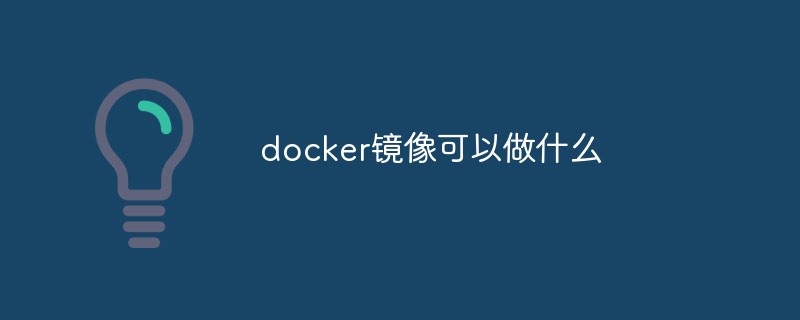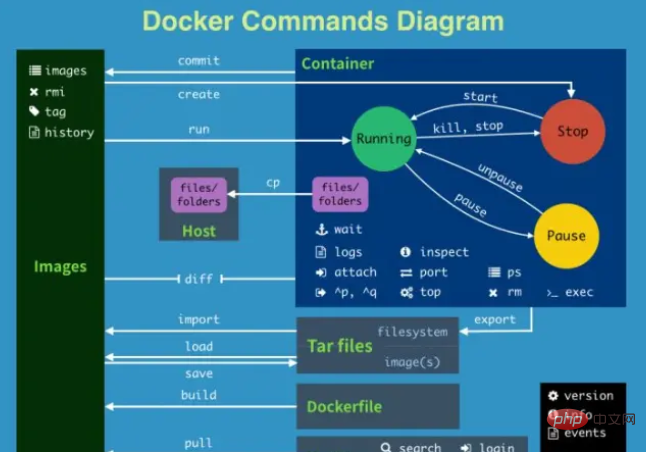What docker images can do
In docker, images can be used to package the software running environment and software developed based on the running environment; the image is the prerequisite for Docker to run the container, and the warehouse is the place where the image is stored, and it is the core of Docker. In addition to providing containers In addition to the programs, libraries, resources, configuration and other files required for runtime, it also contains some configuration parameters prepared for runtime.

The operating environment of this tutorial: linux7.3 system, docker version 19.03, Dell G3 computer.
What can a docker image do?
What exactly is an image?
An image is a lightweight, executable independent software package used to package the software running environment and software developed based on the running environment. It contains all the content required to run a certain software. Includes code, runtime, libraries, environment variables, and configuration files.
The uses of docker images:
1. Images are the prerequisite for Docker to run containers. The warehouse is the place where images are stored, and it is the core of Docker;
2. The image can be regarded as a special file system. In addition to providing the programs, libraries, resources, configuration and other files required for the container to run, it also contains some configuration parameters prepared for the runtime.
Why is there a Docker image?
In the Paas era, it provides a capability called "hosted application". When deploying an application, it is deployed manually or by writing some scripts. The problem faced by such deployment is that the cloud and local environments are consistent.
Docker projects are not much different from Cloud Foundry containers. They are both "sandboxes" implemented using Cgroups and Namespace. The different functions are docker project Docker images. The reason why Paas is very troublesome is that the packaging process for each application is cumbersome for users and requires configuration and modification, which is very laborious.
However, the Docker image was designed to solve this small packaging function and suddenly became famous overnight. So, you might say that the Docker image is a compressed package. Yes, you guessed it, it is like a compressed package file. How does it solve the cloud and local consistency issues faced in the Paas era? It's very simple. It makes an image into a complete operating system with all the files and the corresponding directory structure. Such a compressed package is exactly the same as the operating system used in your local and test environment.
Docker is an open source application container engine that allows developers to package their applications and dependency packages into a portable image and then publish it to any popular Linux or Windows operating system machine. Virtualization can be achieved. Containers completely use the sandbox mechanism and will not have any interfaces with each other.

It can be seen that Docker contains three basic concepts, namely Image, Container and Repository. The image is the prerequisite for Docker to run the container. The warehouse is the place where the image is stored. It can be seen that the image is the core of Docker.
Back to the topic, the Docker image can be regarded as a special file system. In addition to providing the programs, libraries, resources, configuration and other files required for the container to run, it also contains some files prepared for the runtime. Some configuration parameters (such as anonymous volumes, environment variables, users, etc.). The image does not contain any dynamic data, and its content will not be changed after it is built.
Recommended learning: "docker video tutorial"
The above is the detailed content of What docker images can do. For more information, please follow other related articles on the PHP Chinese website!

Hot AI Tools

Undresser.AI Undress
AI-powered app for creating realistic nude photos

AI Clothes Remover
Online AI tool for removing clothes from photos.

Undress AI Tool
Undress images for free

Clothoff.io
AI clothes remover

Video Face Swap
Swap faces in any video effortlessly with our completely free AI face swap tool!

Hot Article

Hot Tools

Notepad++7.3.1
Easy-to-use and free code editor

SublimeText3 Chinese version
Chinese version, very easy to use

Zend Studio 13.0.1
Powerful PHP integrated development environment

Dreamweaver CS6
Visual web development tools

SublimeText3 Mac version
God-level code editing software (SublimeText3)

Hot Topics
 How to exit the container by docker
Apr 15, 2025 pm 12:15 PM
How to exit the container by docker
Apr 15, 2025 pm 12:15 PM
Four ways to exit Docker container: Use Ctrl D in the container terminal Enter exit command in the container terminal Use docker stop <container_name> Command Use docker kill <container_name> command in the host terminal (force exit)
 How to update the image of docker
Apr 15, 2025 pm 12:03 PM
How to update the image of docker
Apr 15, 2025 pm 12:03 PM
The steps to update a Docker image are as follows: Pull the latest image tag New image Delete the old image for a specific tag (optional) Restart the container (if needed)
 How to copy files in docker to outside
Apr 15, 2025 pm 12:12 PM
How to copy files in docker to outside
Apr 15, 2025 pm 12:12 PM
Methods for copying files to external hosts in Docker: Use the docker cp command: Execute docker cp [Options] <Container Path> <Host Path>. Using data volumes: Create a directory on the host, and use the -v parameter to mount the directory into the container when creating the container to achieve bidirectional file synchronization.
 How to check the name of the docker container
Apr 15, 2025 pm 12:21 PM
How to check the name of the docker container
Apr 15, 2025 pm 12:21 PM
You can query the Docker container name by following the steps: List all containers (docker ps). Filter the container list (using the grep command). Gets the container name (located in the "NAMES" column).
 How to restart docker
Apr 15, 2025 pm 12:06 PM
How to restart docker
Apr 15, 2025 pm 12:06 PM
How to restart the Docker container: get the container ID (docker ps); stop the container (docker stop <container_id>); start the container (docker start <container_id>); verify that the restart is successful (docker ps). Other methods: Docker Compose (docker-compose restart) or Docker API (see Docker documentation).
 How to view the docker process
Apr 15, 2025 am 11:48 AM
How to view the docker process
Apr 15, 2025 am 11:48 AM
Docker process viewing method: 1. Docker CLI command: docker ps; 2. Systemd CLI command: systemctl status docker; 3. Docker Compose CLI command: docker-compose ps; 4. Process Explorer (Windows); 5. /proc directory (Linux).
 How to use docker desktop
Apr 15, 2025 am 11:45 AM
How to use docker desktop
Apr 15, 2025 am 11:45 AM
How to use Docker Desktop? Docker Desktop is a tool for running Docker containers on local machines. The steps to use include: 1. Install Docker Desktop; 2. Start Docker Desktop; 3. Create Docker image (using Dockerfile); 4. Build Docker image (using docker build); 5. Run Docker container (using docker run).
 How to start mysql by docker
Apr 15, 2025 pm 12:09 PM
How to start mysql by docker
Apr 15, 2025 pm 12:09 PM
The process of starting MySQL in Docker consists of the following steps: Pull the MySQL image to create and start the container, set the root user password, and map the port verification connection Create the database and the user grants all permissions to the database






